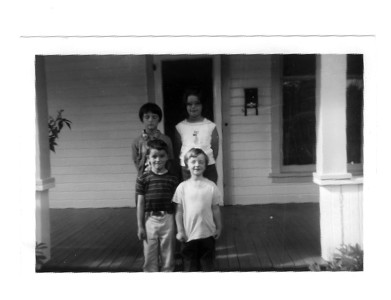Mary Lee Glassburn
A Class Act
I remember it like it was yesterday. It was 1962; I was five years old and in kindergarten. The classroom was large. Actually, it was two rooms of which half of the center wall had been removed to make one big room. My teacher, Mrs. Goodrich, was a tall, slender woman with short dark hair. I liked her. In my eyes she treated everyone fairly.
There were these two students; Susan and Cynthia, who took a dislike of me from the very beginning. They made it clear to me that they came from wealthy families and I did not.
Hi. My name is Cynthia. My friend Susan and I are in Mrs. Goodrich’s kindergarten class. We like it because we get to play with each other every day. There is one person here we really don’t like. Her name is Mary Lee. We really don’t know much about her, but she is way different from us. She doesn’t wear nice clothes or shoes like we do. Really, her clothes look used, and so far she has only worn one pair of shoes all year!
I was wearing faded clothing. I wore an orange and yellow jumper that had been previously worn by my older sisters. It was well used, had a few stains, but it was clean and one of the few things available for me to wear. My shoes were canvas and at one time had been white but were now a dingy gray and beginning to show wear. I was embarrassed by my attire because Susan and Cynthia always wore new clothes and nice shoes. They also made it a point to criticize my clothing almost daily. I felt as if I was “less than” or the “other” in their eyes. I already was aware at the young age of five that there were definite differences in social class.
Somewhere in the middle of the school year, Susan and Cynthia were playing with the wooden blocks on the floor. I was not anywhere near them. As a matter of fact, I was on the other side of the room, playing by myself. The blocks were my favorite things to play with; but today they had got to them first.
Suddenly, I heard the sound of blocks falling. As I looked in the direction of the noise, I heard Susan and Cynthia screaming and crying to Mrs. Goodrich. They said I had run over and knocked down their blocks.
We just don’t want her anywhere near us. So, this morning on the way to school we thought of a plan to get her in trouble. We decided to build a tall tower out of the wooden blocks she was always playing with.
Then we would knock it down and tell our teacher that Mary Lee had run over and wrecked our building. During playtime we implemented our plan. We built it and violently knocked it down. Then, we started screaming and crying so hard that Mrs. G came running over to see what was wrong! Of course we told her that Mary Lee had done it because she wanted to play with the blocks. Mrs. G punished her by not allowing her to play outside at recess.
Out on the playground, Susan and I laughed and laughed. We knew Mary Lee would never come near us again!
I remember feeling overwhelming sadness when my teacher didn’t believe me when I told her I didn’t do it. It was devastating because I knew I had done nothing wrong. To the girls it seemed it was some sort of a victory as they had accomplished what they had set out to do.
I knew they were playing out the borderland of class. I became aware of class issues well before kindergarten. I already knew I was the “other”. I remember watching “Leave it to Beaver” and thinking the Cleavers were the perfect, normal family. Ward had a career, while June (who always looked immaculate), took care of the home and the children. All issues were resolved peacefully and calmly by the end of the show. I dreamed of living like the Cleavers. My family was just the opposite: my mom was a single parent who worked nights with four kids who somehow took care of each other.
Everyone in my kindergarten class came from “normal” two parent households, except me. I was different. This was only reinforced by the behavior and accusations of my schoolmates and perhaps by my own behavior and feelings of inferiority.
The popular toy of the day, “Barbie”, embodied the ideal image: perfect hair, complexion, body, clothes, and shoes. She represented everything I wanted to be. Then there was Jackie Kennedy, the First Lady. In 1962 she conducted a television tour of the White House. I saw Mrs. Kennedy as a symbol of elegance. She was perfect. Just like Barbie, Susan, Cynthia, and my teacher. In my five-year-old mind, I believed I could never attain normal or perfect.
In the late 1950’s and throughout the decade of the 1960’s, race and civil rights were at the forefront of contemporary issues. Although these things were not explicitly an issue for me in kindergarten, I firmly believe it was at that time when I began to identify with the struggles of the Black community. I too felt segregated and judged by my appearance. Because of my borderland of class, I made a conscious decision to try to always treat others the way I desperately wanted to be treated.
I see how the influences that shaped the opinions and actions of my classmates and me at such an early age, were first learned in our family of origin. I have since learned that no person or object is perfect, and I understand the girls were acting out of their own prejudices and pre-formed opinions. Fortunately, I have moved beyond the pain they caused me so many years ago.
Return to Personal Memory Ethnographies
homepage